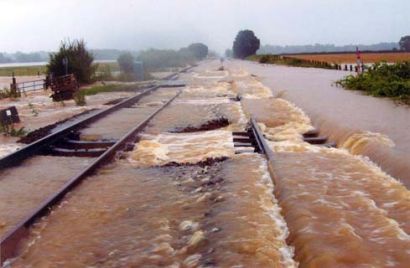HEAVY or persistent rain in autumn and winter has disrupted rail services for decades, but this year and last the railway fell victim to widespread summer flooding.
In June and July 2007, flooding affected the railway in 265 places. Britain had no chance to dry out over the following spring and summer, leaving ground more saturated than usual at the start of autumn, increasing the risk of further flooding.
In August 2008, heavy rain closed Haymarket tunnel, Edinburgh, and the Dundee-Aberdeen line a fortnight later.
In early September floods affected the Newcastle-Carlisle line near Hexham and 26 locations in South Wales, including six where lines were closed.
John Dora, Network Rail’s principal civil engineer for water management, says: “Floods are increasing in frequency. It’s difficult to be definite about whether they’re increasing in magnitude.
“I’m keen to make the railway more resilient for extreme events. Today’s extreme weather may be tomorrow’s norm.”
The climate is not the only culprit. Changes to the way land is used and managed mean less water soaks away. More ground is covered in buildings, tarmac or concrete, stopping the soil acting as a sponge.
This can be a double whammy, as the Thames Valley witnessed last summer. First, torrential rain overwhelmed the railway with surface water. Three or four days later, tracks south of Oxford were flooded by the swollen Thames, carrying the results of the deluge from further upstream.
John adds: “The railway is today much more sensitive to flood waters than 50 years ago, when signalling systems were mechanically operated, telephone wires were strung on poles and no trains had the small-diameter wheels of some rolling stock today.”
Signalling engineers south of Oxford had enough warning of the Thames surge last summer to move point motors (the line was already closed to traffic) out of the flood’s reach. One of John’s aims is to build flood resistance into all engineering infrastructure in vulnerable areas, including during resignalling and track renewal schemes. This could involve placing equipment higher up or in watertight boxes, or by using different technology.
John has been working with the Met Office and Environment Agency to lengthen the warning period for heavy rain. His goal is two days’ notice. Accurate forecasting not only minimises disruption to passengers and freight, but can improve safety. Rain has caused fatal rail accidents in the last 21 years, through a landslip and a bridge collapse.
After last summer’s floods, Network Rail carried out detailed drainage investigations.
“We would like to en-sure all the drainage we have can cater for heavy rain. If it’s working, it makes a huge difference to the consequences.”
This may not always prevent flooding in extreme weather, but it helps. At Fenny Comp-ton, near Banbury, the drain-age system was fully operational in July 2007.
“The rainfall was too much for it, but water drained away quickly and there was no damage. The line was reopened the same day. If the drainage had been blocked, we could have had a lagoon in a cutting, requiring powerful pumps to clear.”
Network Rail is now pressing for a change in the law on drainage.
Currently, downstream landowners must deal with the results if an upstream landowner disrupts drainage. “If you build a new car park or industrial estate, the rate of downstream run-off changes to bring a flush of water on to the railway that our drainage can’t cope with.”
Developments downstream of the railway can also disrupt. In Cardiff, new buildings going up cut off a drainage outlet in 2006. The resulting dampness caused track circuits to malfunction on a key Valley Lines route.
The first Network Rail may learn of such changes is when it is surprised by a water-related problem. It now wants planning applications to include drainage as a mandatory subject for consultation, along with bat populations or road traffic impacts.
Improving the railway’s readiness for heavy rain comes at a cost. Network Rail has included £250 million in its 2009-14 proposal to ORR to fund civil engineering work, and some of the money would be for improved drainage activities.
On the other hand, there are big potential savings. The June and July 2007 floods cost Network Rail £10.5 million for material damage and £25.6 million in compensation to train operators for business interruption. Poor drainage can also reduce the useful life of rail assets, including track.
Keeping a weather eye on rail
2nd December 2008


